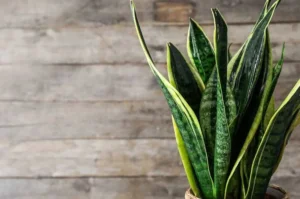The snake plant, scientifically known as Dracaena trifasciata (formerly Sansevieria), is one of the most loved indoor plants for good reason. With its tall, sword-like leaves and vibrant patterns, it’s not only visually striking but also incredibly low-maintenance. Whether you’re new to houseplants or a seasoned plant lover, the snake plant is a smart, stylish choice that fits nearly any space.
Let’s dive into what makes this plant unique, how to care for it, its varieties, and how it can benefit your health and lifestyle.
Snake Plant Care
Caring for a snake plant is straightforward, which is why it’s often recommended for beginners.
Light:
Snake plants do well in almost any lighting. They prefer bright, indirect sunlight but can also survive in low light. However, more light usually means faster growth.
Water:
Overwatering is the most common mistake. Let the soil dry out completely before watering again. In most homes, watering every two to three weeks is enough.
Soil:
Use a well-draining soil mix. Cactus or succulent potting soil is ideal because it prevents soggy roots.
Temperature & Humidity:
Keep your snake plant in temperatures between 60°F and 85°F (15°C to 29°C). Avoid exposing it to freezing temperatures or drafty windows in winter.
Fertilizing:
Fertilize once a month during spring and summer using a balanced, diluted liquid fertilizer. Do not feed the plant in winter.
With minimal effort, your snake plant will reward you with years of healthy growth and vibrant leaves.
Snake Plant Varieties
There are many beautiful types of snake plants, each offering a slightly different look. Here are a few of the most common and eye-catching varieties:
1. Sansevieria trifasciata ‘Laurentii’
Tall leaves with green centers and golden-yellow edges. This is the classic snake plant most people recognize.
2. Sansevieria cylindrica
Cylindrical leaves that grow upright and can be braided. It’s perfect for a modern or minimalistic home.
3. Sansevieria ‘Moonshine’
Silvery green leaves with a soft, matte texture. It’s unique and less common than other varieties.
4. Sansevieria ‘Hahnii’
A compact version with leaves that form a rosette. Ideal for small desks or shelves.
5. Sansevieria ‘Black Gold’
Dark green leaves bordered with a golden edge, great for bold interior design.
Each variety adds its character, whether you prefer bold patterns or soft tones.
Propagating
Snake plants are super easy to propagate, and it’s a great way to grow more plants from a single one.
How to Propagate Snake Plants:
1. Cuttings in Soil:
- Cut a healthy leaf into 3- to 4-inch sections.
- Let the ends dry for a day or two to prevent rotting.
- Plant them upright in the soil.
- Water sparingly and place in indirect light.
2. Cuttings in Water:
- Place the bottom part of a cut leaf in water.
- Change the water every few days.
- After a few weeks, roots will form, and the cutting can be transferred to soil.
3. Division:
- Take the plant out of its pot and gently pull apart the roots into sections.
- Each section should have roots and at least one leaf.
- Replant each section separately.
Propagation is easy, affordable, and a fun way to multiply your plant collection.
Repotting a Snake Plant
While snake plants don’t mind being root-bound, repotting every 2 to 3 years helps keep them healthy.
When to Repot:
- The plant looks crowded or is top-heavy.
- Roots are growing out of the bottom of the pot.
- Soil dries out too quickly.
How to Repot:
- Choose a pot 1–2 inches larger than the current one.
- Gently remove the plant and shake off loose soil.
- Trim any rotten or dead roots.
- Add fresh soil to the new pot, place the plant in it, and fill around it.
- Water lightly and place the plant in indirect sunlight.
Repotting is a great time to check the roots and refresh the soil, which supports new growth.
How Can Plants Help Your Mental Health?
Plants do more than just beautify a room, they can also benefit your emotional and psychological well-being.
Benefits of Snake Plants for Mental Health:
- Reduces Stress: Studies show that simply being around greenery lowers stress and anxiety levels.
- Improves Air Quality: Snake plants remove toxins from the air, helping you breathe easier.
- Enhances Mood: Nurturing a plant can give a sense of purpose and joy.
- Boosts Productivity: Having plants in your workspace can improve focus and creativity.
- Better Sleep: Snake plants release oxygen at night, making them great for your bedroom.
Even a small connection with nature (like watering your plant) can have a calming effect and help improve mental clarity.
Final Thoughts
The snake plant is more than just a decorative accent. It’s a tough, elegant, and beneficial plant that fits perfectly into modern life. Whether you’re looking to freshen your air, add beauty to your home, or reduce stress, this plant delivers on all fronts.
Explore the many varieties, try propagating your own, and enjoy the mental health benefits that come from bringing a bit of green into your everyday environment. With minimal care, your snake plant can thrive for years, making it a rewarding choice for any indoor garden.






